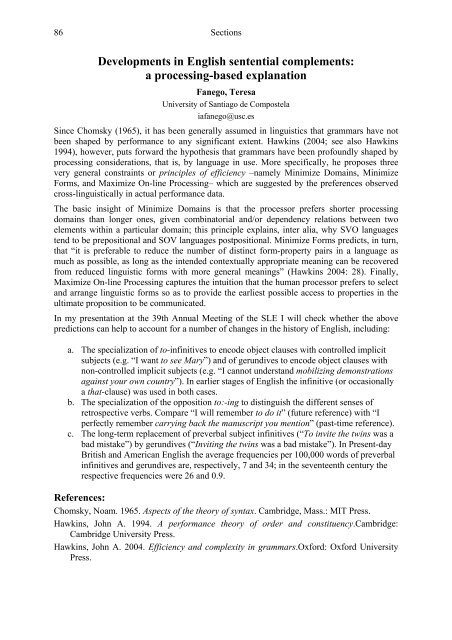Relativism and Universalism in Linguistics - Fachbereich 10 ...
Relativism and Universalism in Linguistics - Fachbereich 10 ...
Relativism and Universalism in Linguistics - Fachbereich 10 ...
Create successful ePaper yourself
Turn your PDF publications into a flip-book with our unique Google optimized e-Paper software.
86 Sections<br />
Developments <strong>in</strong> English sentential complements:<br />
a process<strong>in</strong>g-based explanation<br />
Fanego, Teresa<br />
University of Santiago de Compostela<br />
iafanego@usc.es<br />
S<strong>in</strong>ce Chomsky (1965), it has been generally assumed <strong>in</strong> l<strong>in</strong>guistics that grammars have not<br />
been shaped by performance to any significant extent. Hawk<strong>in</strong>s (2004; see also Hawk<strong>in</strong>s<br />
1994), however, puts forward the hypothesis that grammars have been profoundly shaped by<br />
process<strong>in</strong>g considerations, that is, by language <strong>in</strong> use. More specifically, he proposes three<br />
very general constra<strong>in</strong>ts or pr<strong>in</strong>ciples of efficiency –namely M<strong>in</strong>imize Doma<strong>in</strong>s, M<strong>in</strong>imize<br />
Forms, <strong>and</strong> Maximize On-l<strong>in</strong>e Process<strong>in</strong>g– which are suggested by the preferences observed<br />
cross-l<strong>in</strong>guistically <strong>in</strong> actual performance data.<br />
The basic <strong>in</strong>sight of M<strong>in</strong>imize Doma<strong>in</strong>s is that the processor prefers shorter process<strong>in</strong>g<br />
doma<strong>in</strong>s than longer ones, given comb<strong>in</strong>atorial <strong>and</strong>/or dependency relations between two<br />
elements with<strong>in</strong> a particular doma<strong>in</strong>; this pr<strong>in</strong>ciple expla<strong>in</strong>s, <strong>in</strong>ter alia, why SVO languages<br />
tend to be prepositional <strong>and</strong> SOV languages postpositional. M<strong>in</strong>imize Forms predicts, <strong>in</strong> turn,<br />
that “it is preferable to reduce the number of dist<strong>in</strong>ct form-property pairs <strong>in</strong> a language as<br />
much as possible, as long as the <strong>in</strong>tended contextually appropriate mean<strong>in</strong>g can be recovered<br />
from reduced l<strong>in</strong>guistic forms with more general mean<strong>in</strong>gs” (Hawk<strong>in</strong>s 2004: 28). F<strong>in</strong>ally,<br />
Maximize On-l<strong>in</strong>e Process<strong>in</strong>g captures the <strong>in</strong>tuition that the human processor prefers to select<br />
<strong>and</strong> arrange l<strong>in</strong>guistic forms so as to provide the earliest possible access to properties <strong>in</strong> the<br />
ultimate proposition to be communicated.<br />
In my presentation at the 39th Annual Meet<strong>in</strong>g of the SLE I will check whether the above<br />
predictions can help to account for a number of changes <strong>in</strong> the history of English, <strong>in</strong>clud<strong>in</strong>g:<br />
a. The specialization of to-<strong>in</strong>f<strong>in</strong>itives to encode object clauses with controlled implicit<br />
subjects (e.g. “I want to see Mary”) <strong>and</strong> of gerundives to encode object clauses with<br />
non-controlled implicit subjects (e.g. “I cannot underst<strong>and</strong> mobiliz<strong>in</strong>g demonstrations<br />
aga<strong>in</strong>st your own country”). In earlier stages of English the <strong>in</strong>f<strong>in</strong>itive (or occasionally<br />
a that-clause) was used <strong>in</strong> both cases.<br />
b. The specialization of the opposition to:-<strong>in</strong>g to dist<strong>in</strong>guish the different senses of<br />
retrospective verbs. Compare “I will remember to do it” (future reference) with “I<br />
perfectly remember carry<strong>in</strong>g back the manuscript you mention” (past-time reference).<br />
c. The long-term replacement of preverbal subject <strong>in</strong>f<strong>in</strong>itives (“To <strong>in</strong>vite the tw<strong>in</strong>s was a<br />
bad mistake”) by gerundives (“Invit<strong>in</strong>g the tw<strong>in</strong>s was a bad mistake”). In Present-day<br />
British <strong>and</strong> American English the average frequencies per <strong>10</strong>0,000 words of preverbal<br />
<strong>in</strong>f<strong>in</strong>itives <strong>and</strong> gerundives are, respectively, 7 <strong>and</strong> 34; <strong>in</strong> the seventeenth century the<br />
respective frequencies were 26 <strong>and</strong> 0.9.<br />
References:<br />
Chomsky, Noam. 1965. Aspects of the theory of syntax. Cambridge, Mass.: MIT Press.<br />
Hawk<strong>in</strong>s, John A. 1994. A performance theory of order <strong>and</strong> constituency.Cambridge:<br />
Cambridge University Press.<br />
Hawk<strong>in</strong>s, John A. 2004. Efficiency <strong>and</strong> complexity <strong>in</strong> grammars.Oxford: Oxford University<br />
Press.

















